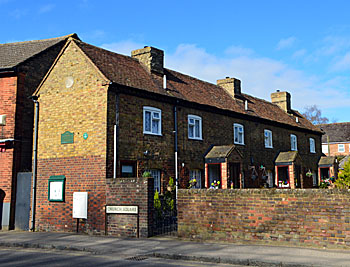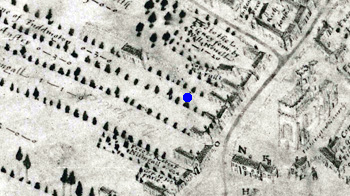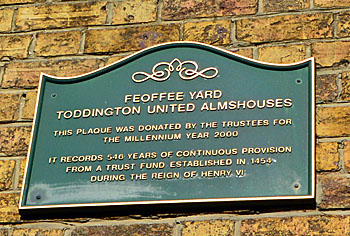Feoffee Yard Almshouses Toddington

Feoffee Yard Almshouses March 2016
In 2000 a leaflet called "Feoffee Cottages A Brief History" was written by an unknown author. The leaflet reads as follows: "On the Sunday after the feast of Saint Michael the Archangel in the year 1454, Thomas Wykelwode, the Rector of Saint George's Church and William Grenefeld, the Warden of the Hospital of Saint John the Baptist in Toddington surrendered to ten named Trustees or Feoffees and their assigned successors some fifty small pieces of their land scattered throughout the parish. These were to become known as the "Town Lands" and the income they produced was to form the earliest known charitable institution in Toddington, which has survived to this day".
"The ground on which Feoffee Cottages now stand is part of the early Town Lands. It is shown on the map of Toddington drawn by Radulph Agas in 1581, where it is marked "Free to the Towne of Tuddington" [shown by a blue dot on the image below]. Much larger than the Feoffee Yard of today, it was in the form of the long narrow strips of the time and amounted to three roods, or three-quarters of an acre. From about 1700 to the early 1800s it was known as "Workhouse Yard", taking its name from the workhouse that stood on the land during that period [parish workhouses closed after the Poor Law Amendment Act of 1834]. Cottages on the site are first mentioned in 18th Century documents, which describe five houses and a workhouse belonging to the Charity. The workhouse was let by the Trustees to the parish, but the Overseers, who were responsible for the poor, employed a Master to run it".

The site of the Feoffee Almshouses in 1581
"By the time of the Charity Commissioners' report on Toddington in 1821, the original buildings on the site had become very old and expensive to maintain. Unlike today, the cottages were occupied rent-free and the cost of maintaining the buildings amounted to more than half the total income from the rest of the property and land administered by the Trustees. The situation clearly became worse because the Trustees, at their meeting on 10th September 1828, agreed that the cottages should be taken down. The following March, the workhouse suffered a similar fate".
"In April 1829 Mr James Bass, a local builder, was commissioned to build six new houses on the cleared land and by October of that year Feoffee Cottages had been completed at a cost of £201 17s 3d. These original houses were very different from those of today. Builder's drawings still survive, showing a terrace of single storey, one-room dwellings with tall chimneys. The walls were of single brick construction with three exterior doors, each serving a pair of cottages. Joined on to the far end of the terrace was a communal washhouse and toilet. It was decided by the Trustees that the houses would be "occupied by widows or maids of good character and not under the age of fifty years".
"Only thirty seven years later the houses were extensively modified. In May 1866 Mr M Horley drew up plans for adding a second storey, this giving the occupants a separate upstairs bedroom. This addition can be clearly seen today in the different pattern of bricks used. In addition, the three original exterior doorways were removed and six new individual front doors installed, leading directly into the living rooms of the houses. Sometime later, a separate bungalow was built as an additional almshouse. By now the land occupied by the houses had become known as "Widows' Yard".
"During the 19th Century, a pump in front of the cottages provided water for the occupants but by the early 1900s the well had become unusable and the ladies were obliged to use the pump on the Green. In December 1919 an agreement was drawn up to pay a Mr Allen one shilling a year for the use of the pump on his nearby property. When this arrangement came to an end some years later, Edwin Bsbister, known locally as "little Edwin", was employed to collect water from the pump on the Green for which he was paid three shillings a week".
"At this time the Trustees began to sell off certain pieces of land in order to provide capital for investment. At the time of the Inclosure in 1800, many of the original Town lands throughout the parish had been exchanged for about 35 acres at Fancott but the plots of ground within the Town of Toddington had been retained. In 1935 an offer was received from Wells and Winch Limited, owners of the Sow and Pigs, to purchase the rear part of the long strip of land on which the cottages stood. After some negotiation the original offer of £80 was increased to £100 and the sale was completed, leaving only the ground and garden occupied by the houses and bungalow, which we now know as Feoffee Yard".
"By 1976 the row of six houses, with no separate kitchens, bathrooms or inside toilet facilities could no longer be considered suitable for modern living requirements. The only solution was to increase the available space by reducing the number of houses. This was achieved by combining two houses into one, resulting in three dwellings, each with ground floor living room and kitchen, and a bedroom and bathroom upstairs. Twenty five years later, a generous grant from the Housing Corporation has enabled the Trustees to complete a major renovation of the property, with the results that you see today".
"All the charities of Toddington are now amalgamated under a scheme of the Charity Commissioners and entitled the Toddington United Almshouse Charities. In January 2000 the Trustees placed a plaque on the wall of Feoffee Cottages to mark 546 years of continuous service to the Town".

Feoffee Yard Almshouses plaque